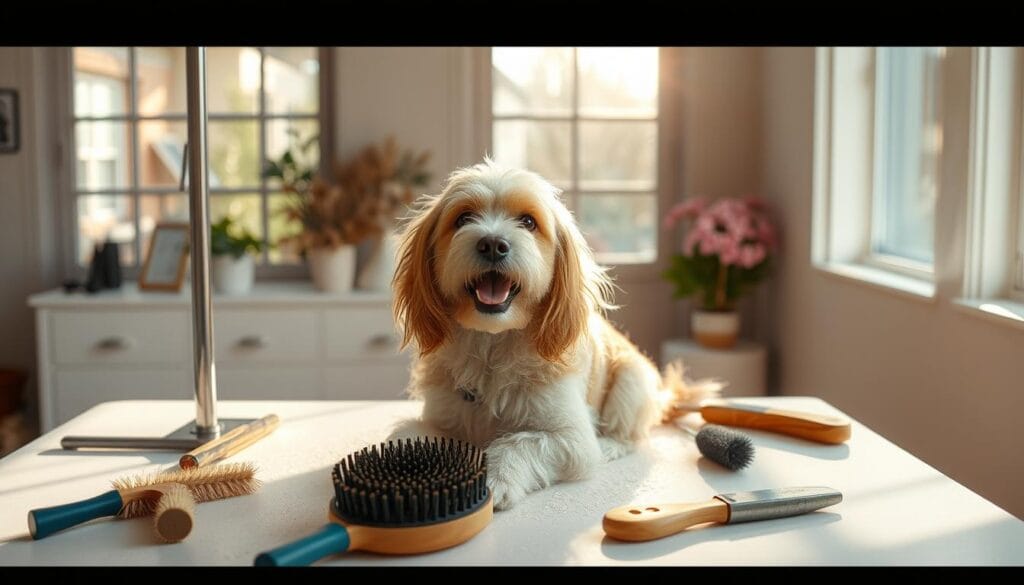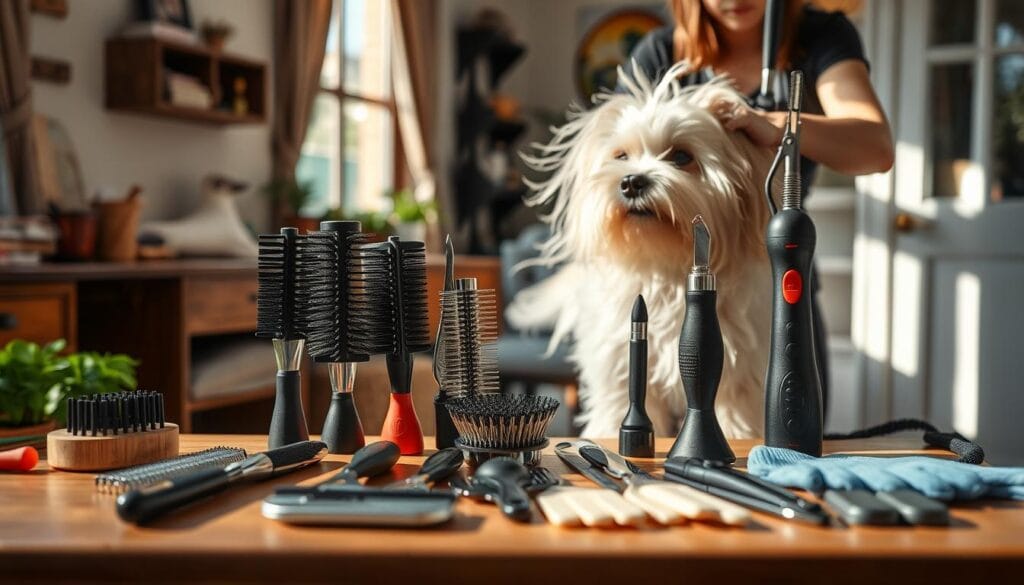As a dog owner, you know the hassle of dog shedding. There are ways to reduce dog shedding and keep your home clean. The right techniques and tools can help you achieve a fur-free home. You can look into different solutions, like changing your dog’s diet or professional grooming, to find what works best for your pet.
To tackle dog shedding, it’s key to understand why it happens. Knowing the causes helps you find the best solutions. You can use various methods, such as changing your dog’s diet or using the right grooming tools, to keep your home clean and fur-free.
Table of Contents
Understanding Why Dogs Shed: The Science Behind Fur Loss
To manage dog shedding, it’s key to know why it happens. Dogs shed for many reasons, like natural cycles, breed patterns, and health issues. Knowing these can help you control shedding and prevent hair loss.
Managing dog shedding starts with understanding natural cycles. These cycles help your dog’s coat adjust to the seasons. Some breeds, like Siberian Huskies, shed a lot in spring and fall. Others, like Poodles, shed less all year.
Natural Shedding Cycles
Natural shedding cycles change with daylight, temperature, and humidity. As days get longer or shorter, your dog’s coat sheds or grows new fur. This keeps your dog warm and protects its skin.
Breed-Specific Shedding Patterns
Different breeds shed in different ways. Short-haired breeds, like Boxers, shed less than long-haired ones, like Afghan Hounds. Knowing your dog’s breed can help you manage shedding and prevent hair loss.
Health-Related Shedding Causes
Health issues, like skin allergies or fleas, can cause excessive shedding. If your dog sheds a lot, see a vet to check for health problems. Fixing these issues can keep your dog’s coat healthy and reduce shedding.
Understanding dog shedding helps you find ways to manage it. This knowledge lets you care for your dog’s coat better and reduce shedding at home.
Essential Dog Shedding Solutions for Every Pet Owner
As a dog owner, dealing with dog shedding can be tough. But, with the right tips for reducing dog shedding, you can keep your home fur-free. Regular dog grooming for shedding is key to less shedding and no matting. Use slicker, pin, or bristle brushes based on your dog’s coat.
Some important tips for reducing dog shedding include regular nail trimming, ear cleaning, and baths. These simple steps can cut down on shedding and keep your dog healthy. Also, the right dog grooming for shedding tools and methods can make a huge difference. For instance, a deshedding tool can help get rid of loose hair and lessen shedding.

- Brush your dog often to cut down on shedding and stop matting
- Choose the right brushes and tools for your dog’s coat
- Regular nail trimming, ear cleaning, and baths can help reduce shedding
- Think about using a deshedding tool to remove loose hair
By following thesetips for reducing dog sheddingand using the rightdog grooming for sheddingtools and methods, you can keep your home fur-free. And your dog will be happy and healthy.
Dietary Approaches to Reduce Excessive Shedding
As a dog owner, you want to keep your home clean and reduce dog shedding. A balanced diet is key to this goal. The right foods and supplements can help stop excessive shedding and promote a healthy coat.
Omega-3 rich foods, like salmon and flaxseed, are important. They reduce inflammation and improve skin and coat health. Vitamin supplements, such as biotin and vitamin E, also help. Make sure your dog always has fresh water to keep their coat healthy.
Key Dietary Components
- Omega-3 rich foods: salmon, flaxseed, and other fatty fish
- Vitamin supplements: biotin, vitamin E, and other essential vitamins
- Adequate hydration: fresh water and limited treats
By changing your dog’s diet, you can reduce shedding. Always talk to your vet before making big changes. The right diet can lead to a healthier coat and less shedding.
Professional Grooming Techniques You Can Master at Home
As a dog owner, you want to give your pet the best care. This includes reducing dog shedding. Mastering professional grooming at home is a great way to do this. It helps keep your home fur-free and your dog healthy.
Regular brushing is key in dog grooming. It helps reduce shedding. Use a slicker brush or a pin brush to remove loose hair and spread natural oils. Also, nail trimming and ear cleaning are important for your dog’s health and less shedding.
To cut down on shedding, use deshedding tools like a Furminator or a shedding rake. These tools are made to remove loose hair and reduce shedding. Adding them to your grooming routine can help keep your home clean.

- Regular brushing to reduce matting and tangling
- Nail trimming to prevent overgrowth
- Ear cleaning to prevent infections
- Using deshedding tools to reduce loose hair
By following these tips and adding them to your dog’s grooming routine, you can reduce shedding. This makes your home fur-free and uses effective dog shedding solutions.
Best Tools and Products for Managing Dog Hair
To manage dog shedding, you need the right tools and products. There are many options, making it hard to pick the best for your dog. The right tools can help prevent dog hair loss.
Regular grooming is key to managing dog shedding and preventing hair loss. Start with a good quality brush, like a slicker, pin, or bristle brush. These are made for different coat types. Deshedding tools, such as a Furminator or shedding rake, can also help remove loose hair and reduce shedding.
Brush Types and Their Uses
- Slicker brushes: ideal for dogs with long, curly, or thick coats
- Pin brushes: suitable for dogs with short, smooth coats
- Bristle brushes: perfect for dogs with medium-length coats
Also, deshedding tools and vacuum cleaners for pet hair can keep your home clean. Using these tools and products helps manage dog shedding and prevent hair loss. This keeps your home clean and your dog happy and healthy.
Deshedding Tools Comparison
When picking deshedding tools, think about your dog’s coat type and shedding level. Popular tools include the Furminator, shedding rake, and deshedding glove. These tools can reduce shedding and prevent hair loss, making them crucial for dog grooming.
Creating a Regular Maintenance Schedule
To control dog shedding, create a routine that fits you and your pet. Set aside time each week for grooming. This will help reduce shedding and keep your home clean.
Choose a specific day and time for grooming tasks like brushing, nail trimming, and ear cleaning. Regular grooming prevents matting, tangling, and excessive shedding. It makes managing your dog’s coat easier.
Consistency is crucial for reducing dog shedding. Schedule regular baths and deshedding sessions. This keeps your dog’s coat healthy and strong. Use these sessions to check your dog’s skin and coat for any issues.
By sticking to a regular schedule, you can better control dog shedding. This prevents excessive hair loss.
Some important tasks to include in your maintenance schedule are:
- Brushing: 2-3 times a week to prevent matting and tangling
- Nail trimming: every 4-6 weeks to prevent overgrowth
- Ear cleaning: weekly to prevent infections
- Bathing and deshedding: every 2-3 months to keep your dog’s coat healthy
Remember, every dog is different. Tailor your maintenance schedule to your pet’s specific needs. This way, you can control dog shedding and enjoy a cleaner, healthier home.
Environmental Modifications to Control Shedding Impact
As a dog owner, you know how shedding can affect your home. To lessen the impact, try some environmental changes. Using air filtration systems is a good start. They help remove dog hair and dander from the air.
Protecting your furniture is another smart move. Use throw blankets and washable covers to stop dog hair from settling. Regular vacuuming and mopping also keep your floors clean and free of fur.
Some effective ways to control shedding impact include:
- Using HEPA filters to reduce dog hair and dander in the air
- Implementing furniture protection strategies, such as using throw blankets and washable covers
- Establishing floor cleaning protocols, such as regular vacuuming and mopping
By making these changes, you can reduce dog shedding. This makes your home cleaner and healthier for you and your dog.
| Environmental Modification | Benefits |
|---|---|
| Air Filtration Systems | Removes dog hair and dander from the air, reducing shedding impact |
| Furniture Protection | Prevents dog hair from accumulating on furniture, making cleaning easier |
| Floor Cleaning Protocols | Keeps floors clean and fur-free, reducing shedding impact |
Natural Remedies and Holistic Approaches
Looking for ways to cut down on dog shedding? Natural remedies and holistic methods can help. Try adding omega-3 rich flaxseed and biotin to your dog’s food. These can reduce inflammation and make their skin and coat healthier, leading to less shedding.
Essential oils like lavender and tea tree can also help. Add a few drops to their bath water or use them in a diffuser. This can create a calm and relaxing space. Also, therapies like acupuncture and massage can reduce stress and improve health, which helps with shedding.
- Herbal supplements: omega-3 rich flaxseed, biotin, and other herbs that promote healthy skin and coat
- Essential oil solutions: lavender, tea tree oil, and other oils that reduce inflammation and promote healthy skin
- Alternative therapies: acupuncture, massage, and other therapies that reduce stress and promote overall health
Always talk to a vet before trying new remedies or therapies, especially if your dog has allergies. By using these natural and holistic methods, you can help your dog stay healthy and happy, with less shedding.
When to Seek Veterinary Help for Excessive Shedding
As a dog owner, it’s key to know when your dog’s shedding might mean a health problem. While dog shedding solutions like grooming and diet changes can help reduce dog shedding, too much shedding is a worry. If your dog sheds more than usual, getting vet help is important to check for health issues.
Some signs that mean you should see a vet include:
- Excessive shedding that’s not seasonal
- Skin irritation or redness
- Changes in appetite or energy level
- Presence of fleas, ticks, or other parasites
Your vet can find any health problems and tell you how to treat them. Getting vet help means your dog gets the care they need to stay healthy and happy.
Early detection and treatment are crucial for dealing with excessive shedding and health issues. By working with your vet and using effective dog shedding solutions, you can cut down on shedding. This keeps your home fur-free.
Conclusion: Maintaining a Fur-Free Home Year-Round
To keep your home fur-free all year, you need a solid plan. This plan should include regular grooming, a good diet, and smart environmental changes. By using the tips from this article, you can handle dog shedding, stop too much hair loss, and control dog hair in your home.
Keep up with your dog’s grooming. Brush them often, bathe them regularly, and use deshedding tools. Also, add omega-3 foods and vitamins to their diet to keep their skin and coat healthy. Use air filters, protect your furniture, and clean your floors well to reduce dog hair in your home.
With effort and dedication, you can have a fur-free home and a happy, healthy dog. By using the dog shedding solutions from this article, you’ll keep your home clean and comfortable for your pet all year.

